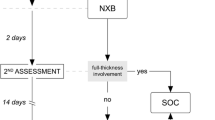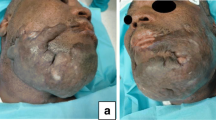Abstract
Background
Deep facial burns present unique challenges due to the risk of scarring and contracture which can negatively impact patients’ cosmesis and function. Enzymatic debridement of burns with bromelain-based agents, such as Nexobrid™, may improve scarring through maximal preservation of viable tissue. However, Nexobrid™ use in facial burns is poorly described in the literature.
Methods
We conducted a single-centre case series, retrospectively reviewing all patients treated with Nexobrid™ for deep facial burns between January 2016 and July 2022.
Results
We identified five female patients aged 27–69 with 1–6% deep burns of different aetiologies (flame, contact and flash flame). All patients received Nexobrid™ within 72 hours of injury and underwent allograft application the following day. Length of hospital stay ranged from 3 to 10 days (mean 4.6). Four out of five patients underwent delayed autograft at 15 to 29 days (mean 25), and the time to complete healing varied from 24 to 93 days (mean 52). Patients displayed good aesthetic and functional outcomes at follow-up ranging from 3 to 36 months.
Conclusions
From our experience at Queen Victoria Hospital, we observed good aesthetic and functional outcomes using Nexobrid™ in deep facial burns. The process is safe and effective, and we hope that our contribution will encourage further research and practice in this field.
Level of evidence
Level IV, Therapeutic.





Similar content being viewed by others
References
Hirche C, Kreken Almeland S, Dheansa B, Fuchs P, Governa M, Hoeksema H, Korzeniowski T, Lumenta DB, Marinescu S, Martinez-Mendez JR, Plock JA, Sander F, Ziegler B, Kneser U (2020) Eschar removal by bromelain based enzymatic debridement (Nexobrid®) in burns: European consensus guidelines update. Burns 46:782–796
Kwon SH, Barrera JA, Noishiki C, Chen K, Henn D, Sheckter CC, Gurtner GC (2020) Current and emerging topical scar mitigation therapies for craniofacial burn wound healing. Front Physiol 29:916
Janzekovic Z (1970) A new concept in the early excision and immediate grafting of burns. J Trauma 10:1103–1108
Edmondson SJ, Ali Jumabhoy I, Murray A (2018) Time to start putting down the knife: a systematic review of burns excision tools of randomised and non-randomised trials. Burns 44:1721–1737
Horch RE, Jeschke MG, Spilker G, Herndon DN, Kopp J (2005) Treatment of second degree facial burns with allografts--preliminary results. Burns 31:597–602
Leon-Villapalos J, Eldardiri M, Dziewulski P (2010) The use of human deceased donor skin allograft in burn care. Cell Tissue Bank 11:99–104
Krieger Y, Rubin G, Schulz A, Rosenberg N, Levi A, Singer AJ, Rosenberg L, Shoham Y (2017) Bromelain-based enzymatic debridement and minimal invasive modality (mim) care of deeply burned hands. Ann Burns Fire Disasters 30:198–204
Joo HS, Choi JH (2021) Experiences of bromelain-based enzymatic debridement (Nexobrid) in burn patients: a clinical report. J Wound Manag Res 17:207–212
Chae JK, Kim JH, Kim EJ, Park K (2016) Values of a patient and observer scar assessment scale to evaluate the facial skin graft scar. Ann Dermatol 28:615–623
Medical Research Council, NHS Health Research Authority. Is my study research? Available online at: https://www.hra-decisiontools.org.uk/research. Accessed July 2022
Singer AJ, McClain SA, Taira BR, Rooney J, Steinhauff N, Rosenberg L (2010) Rapid and selective enzymatic debridement of porcine comb burns with bromelain-derived Debrase: acute-phase preservation of noninjured tissue and zone of stasis. J Burn Care Res 31:304–309
Schulz A, Perbix W, Shoham Y, Daali S, Charalampaki C, Fuchs PC, Schiefer J (2017) Our initial learning curve in the enzymatic debridement of severely burned hands - management and pit falls of initial treatments and our development of a post debridement wound treatment algorithm. Burns 43:326–336
Schulz A, Fuchs PC, Rothermundt I, Hoffmann A, Rosenberg L, Shoham Y, Oberländer H, Schiefer J (2017) Enzymatic debridement of deeply burned faces: healing and early scarring based on tissue preservation compared to traditional surgical debridement. Burns 43:1233–1243
Ferancikova N, Bukovcan P, Sarkozyova N, Dragunova J, Cucorova V, Koller J (2020) Bromelain-based enzymatic debridement as a treatment of choice in high-risk patient with deep facial burns, a case report. Int J Surg Case Rep 71:6–10
Author information
Authors and Affiliations
Corresponding author
Ethics declarations
Funding
The authors declare that no funds, grants or other support were received during preparation of this manuscript.
Ethics approval
The study protocol was registered as ‘Service Evaluation’ with the local research and audit department. Therefore, ethical approval was not required, in line with UK Health Research Authority guidelines.
Consent for publication
The authors confirm that patients provided constent for sharing their data. Additional informed patient consent was obtained for publication of the images in Figs. 2, 3, 4, and 5.
Competing interests
Alexandra MacKenzie, Maria Chicco and Baljit Dheansa declare no competing interests.
Additional information
Publisher’s note
Springer Nature remains neutral with regard to jurisdictional claims in published maps and institutional affiliations.
Rights and permissions
Springer Nature or its licensor (e.g. a society or other partner) holds exclusive rights to this article under a publishing agreement with the author(s) or other rightsholder(s); author self-archiving of the accepted manuscript version of this article is solely governed by the terms of such publishing agreement and applicable law.
About this article
Cite this article
MacKenzie, A., Chicco, M. & Dheansa, B. Enzymatic debridement of deep facial burns with Nexobrid™: the Queen Victoria Hospital experience. Eur J Plast Surg 46, 1315–1322 (2023). https://doi.org/10.1007/s00238-023-02100-1
Received:
Accepted:
Published:
Issue Date:
DOI: https://doi.org/10.1007/s00238-023-02100-1




